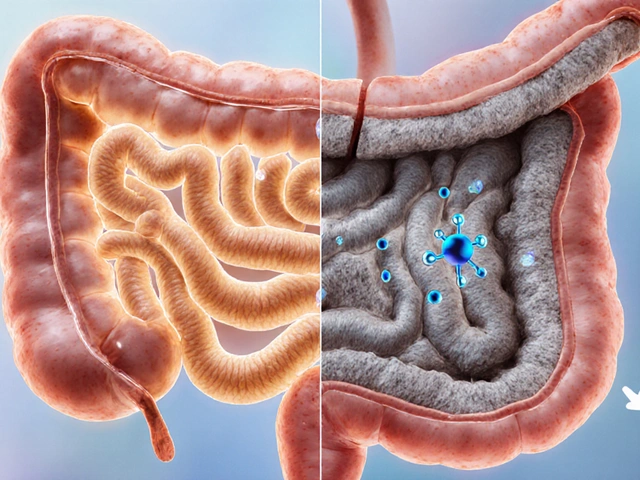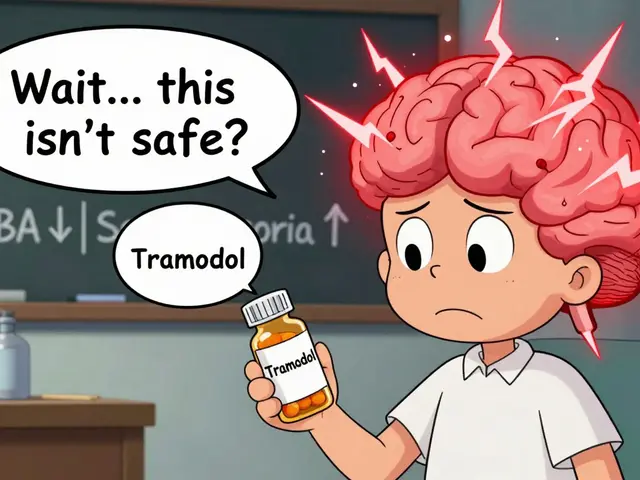Latanoprost Follow-Up Frequency Calculator
This tool estimates how often you should schedule follow-up appointments based on your current condition and risk factors.
When you’re prescribed latanoprost a prostaglandin analog used to lower intraocular pressure in glaucoma patients, the medication itself is just one piece of the puzzle. Consistent check‑ins with your eye doctor keep the pressure in check, spot trouble early, and help you stay on track with the treatment plan.
Key Takeaways
- Follow‑up visits let doctors measure intraocular pressure (IOP) and adjust treatment before damage occurs.
- Typical schedules range from every 3months for new or high‑risk patients to once a year for stable cases.
- Appointments include tonometry, visual‑field testing, and optic‑nerve imaging to catch subtle changes.
- Watch for side‑effects like eye redness, dark eyelash pigment, or sudden vision loss - they signal an earlier visit may be needed.
- Bring a medication list, note any missed doses, and prepare questions to make each visit count.
Why Follow‑up Matters for Glaucoma Management
Glaucoma a group of eye diseases that damage the optic nerve, often due to high intraocular pressure doesn’t announce itself with dramatic symptoms until it’s advanced. The goal of latanoprost is to keep that pressure low, but the eye’s response can vary over time. Regular monitoring lets your ophthalmologist a medical specialist focused on eye health and disease catch three key scenarios:
- Insufficient pressure control: If IOP creeps above target, the doctor may tweak the dose or add another medication.
- Progressive optic‑nerve damage: Even with stable pressure, the optic nerve can still deteriorate; imaging shows when that’s happening.
- Adverse reactions: Some users develop intolerance; early detection prevents long‑term complications.
Neglecting appointments means missing the window to intervene, and once vision loss sets in, it’s irreversible.
What Happens During a Typical Follow‑up
A standard visit is more than a quick eye‑drop check. Here’s what you can expect:
- Tonometry a test that measures the pressure inside the eye - the cornerstone of glaucoma care. Machines like Goldmann applanation tonometers or newer handheld devices provide the exact pressure reading.
- Visual‑field testing a computerized assessment that maps your peripheral vision - subtle blind spots often appear before you notice them.
- Optical Coherence Tomography (OCT) a non‑invasive scan that shows the thickness of the retinal nerve fiber layer - helps gauge nerve health over time.
- Review of medication adherence - the doctor will ask how consistently you apply latanoprost, whether you miss doses, and if you experience irritation.
- Discussion of side‑effects - redness, itching, or darkening of the iris are common; unusual symptoms may prompt a change in therapy.
How Often Should You Schedule a Visit?
Frequency isn’t one‑size‑fits‑all. Your doctor tailors the schedule based on two main factors: disease severity and stability of IOP.
| Risk Category | Typical Interval | Key Monitoring Tests |
|---|---|---|
| New diagnosis / High IOP | Every 3months | Tonometry, Visual‑field, OCT |
| Stable, early‑stage glaucoma | Every 6months | Tonometry, Visual‑field |
| Well‑controlled, low‑risk | Yearly | Tonometry, Optic‑nerve imaging |
If your pressure is consistently on target and imaging shows no progression, your doctor may stretch the interval. Conversely, any sign of change-spiking IOP, new visual‑field defects, or worsening OCT measurements-will trigger a tighter schedule.

Warning Signs That Demand an Earlier Appointment
Even with a solid follow‑up plan, you should call in sooner if you notice any of the following:
- Sudden eye pain or redness that doesn’t improve within a day. \n
- Rapid vision blur, especially in the peripheral field.
- Darkening of the iris or increased eyelash pigmentation that causes cosmetic concerns.
- Persistent itching or a foreign‑body sensation after applying the drop.
- Missing more than two consecutive doses of latanoprost.
These clues often signal that the medication isn’t working as expected or that your eye is reacting poorly. Prompt evaluation can prevent irreversible nerve loss.
Tips to Make the Most of Your Appointment
- Bring a medication list. Include all eye drops, oral meds, and over‑the‑counter supplements; interactions can affect pressure control.
- Note dosing consistency. Write down which days you missed a dose and why-this helps the ophthalmologist adjust the regimen.
- Prepare questions. Examples: “Do I need a different drop if I’m noticing redness?” or “What lifestyle changes can further protect my optic nerve?”
- Carry recent test results. If you had a visual‑field test done at a different clinic, bring a copy. It speeds up comparison.
- Ask about side‑effects. Understanding what’s normal versus alarming helps you act quickly.
Common Pitfalls & How to Avoid Them
Even diligent patients slip up. Here are the top errors and simple fixes:
- Missing appointments. Set automated calendar reminders a week and a day before the visit. Treat the appointment like a prescription you can’t skip.
- Inconsistent drop technique. Use a mirror, pull the lower lid down gently, and let the drop fall without touching the eye. Practice makes it routine.
- Skipping doses. Keep the bottle on your night‑stand or bathroom sink-places you naturally see them. Pair the drop with another daily habit (e.g., brushing teeth).
- Ignoring mild side‑effects. A little redness is common, but if it worsens or is accompanied by pain, call the office. Early tweaks can prevent abandonment of therapy.
Quick Pre‑Visit Checklist
- ✔️ List all eye‑drop brands and strengths.
- ✔️ Write down any missed doses and reasons.
- ✔️ Note any new symptoms (pain, vision changes, discoloration).
- ✔️ Gather previous test results (tonometry, visual‑field, OCT).
- ✔️ Prepare 2‑3 questions for the doctor.
Frequently Asked Questions
How long does it take for latanoprost to lower eye pressure?
Most patients see a 20‑30% reduction within 24hours, but the full effect stabilizes over a few weeks. That’s why the first follow‑up is usually scheduled 4‑6weeks after starting the drop.
Can I miss a single dose of latanoprost?
Missing one dose generally won’t cause a dramatic pressure spike, but repeated missed doses can let IOP creep upward. If you forget, resume the next scheduled dose-not a double‑dose.
Are there alternatives if latanoprost makes my eyes red?
Yes. Your ophthalmologist may switch you to another prostaglandin analog (e.g., bimatoprost) or a different class like a beta‑blocker. The key is to keep pressure low while minimizing irritation.
What should I do if I notice darkening of my iris?
Iris darkening is a known, usually harmless effect of prostaglandin drops. If the change worries you, discuss it at your next visit; the doctor can evaluate whether the benefit outweighs the cosmetic impact.
Is annual monitoring enough for stable glaucoma?
For low‑risk patients with consistently controlled pressure and unchanged imaging, yearly exams are often sufficient. However, any new symptom should prompt an earlier check.







NANDKUMAR Kamble
September 29, 2025 AT 01:43I find it unsettling how the follow‑up schedule is presented as a simple calculator. It feels like a veneer masking a deeper agenda to keep patients tied to a monthly prescription cycle. The more you look, the more the numbers seem engineered.
namrata srivastava
September 29, 2025 AT 01:51The contemporaneous stratification of risk categories via a digital interface engenders a pseudo‑empirical paradigm, wherein the pharmacotherapeutic compliance matrix is ostensibly quantified. Nonetheless, the ontological underpinnings of such algorithmic determinations remain opaque, inviting a critique of evidentiary rigor.
Priyanka arya
September 29, 2025 AT 02:00Yo, they got us thinking a simple drop will fix everything, but what if the real agenda is to keep us glued to the clinic for endless checks? 👀💊 The system loves a good routine, and we’re just the puppets dancing to its beat! 🌐✨
Loren Kleinman
September 30, 2025 AT 04:40Regular follow‑up appointments for latanoprost users embody more than mere procedural inconvenience; they constitute a cornerstone of ocular health stewardship. Each visit provides an opportunity to reconfirm that intraocular pressure remains within the therapeutic window, a metric that can fluctuate subtly over time. Even when a patient perceives no symptoms, the optic nerve may still undergo insidious degeneration that only imaging can reveal. Tonometry offers a quantitative snapshot, while visual‑field testing uncovers functional deficits that precede noticeable vision loss. Optical coherence tomography, meanwhile, delivers structural insight, highlighting thinning of the retinal nerve fiber layer. The convergence of these data points enables the ophthalmologist to adjust treatment before irreversible damage accrues. In the initial months after starting latanoprost, pressure reduction often stabilizes, but the biological response can vary, necessitating a check at four to six weeks. Subsequent appointments at three‑month intervals for high‑risk patients ensure that any upward pressure trends are intercepted promptly. For those with stable, early‑stage disease, semi‑annual reviews balance vigilance with practicality. When patients have achieved sustained control and exhibit unchanged imaging, an annual review may suffice, reducing the burden while maintaining safety. Moreover, regular visits foster adherence, as clinicians can observe drop technique, address side‑effects, and reinforce the importance of consistent dosing. Side‑effects such as conjunctival hyperemia or iris pigmentation, while generally benign, can affect quality of life and prompt therapeutic switches. Early identification of adverse reactions prevents patients from abandoning therapy altogether. The relational aspect of these appointments also builds trust, encouraging patients to report subtle changes that might otherwise be dismissed. Ultimately, the systematic scheduling of follow‑up visits embodies a proactive strategy, shifting care from reactive crisis management to anticipatory preservation of vision.
Amanda Joseph
September 30, 2025 AT 04:48Oh great, another reminder to put drops in my eye – because I love paying for appointments.
Kevin Aniston
September 30, 2025 AT 04:56Hey, don’t get discouraged if the schedule feels overwhelming. Think of each appointment as a checkpoint that keeps you on track toward preserving your vision. The doctor can fine‑tune the regimen, and you’ll learn tricks to make drop application smoother each time. Consistency really does pay off, and these regular visits are the safety net that catches any unexpected spikes. Keep a calendar reminder, bring your medication list, and you’ll find the process becomes routine rather than a hassle.
kiran kumar
October 1, 2025 AT 08:26People act like they have no choice but to follow the doc's timeline but really most of them ignore side effects until it's too late you gotta question why we trust pharma so blind
Brian Johnson
October 1, 2025 AT 08:35I see a lot of patients underestimate the value of those quarterly checks. Even a small pressure fluctuation can signal a bigger issue, so staying on schedule is wise.
Justin Elms
October 2, 2025 AT 12:13Sticking to the recommended follow‑up plan is one of the best things you can do for your eyes – it catches problems early and keeps the pressure steady, making sure latanoprost works its magic.
Jesse Stubbs
October 2, 2025 AT 12:21Ugh, another boring eye exam – same old routine.
Sydnie Baker
October 2, 2025 AT 12:30The procedural cadence delineated herein exemplifies a quintessential model of prophylactic ocular management, wherein systematic surveillance mitigates the stochastic trajectory of glaucomatous neuropathy.